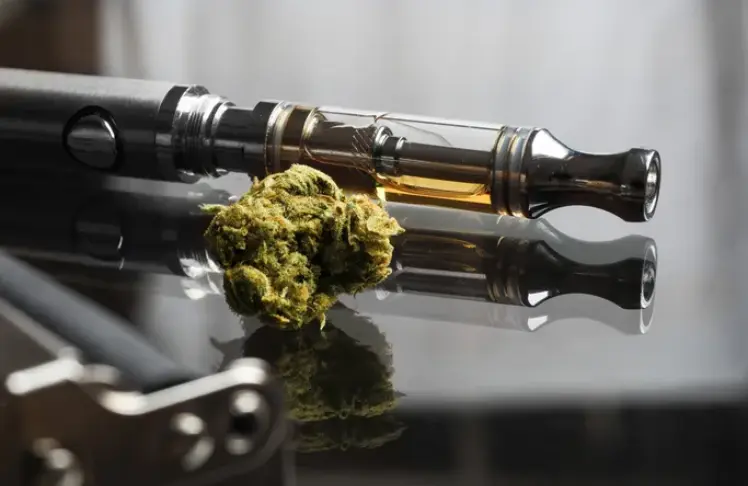
Sweeping changes in laws decriminalizing marijuana possession or use have made the drug easier than ever to obtain. With 24 states legalizing weed for recreational use in the last decade, nearly three-quarters of the U.S. population live in a state where consuming weed is legal.
But although only consumers 21 or older are allowed to legally buy it over the counter, the increasing legalization of recreational weed, experts say, has helped make highly potent forms of it more widely available. and that underage users are getting their hands on it.
In New York, for example, both teachers and students say they’re seeing more and younger students coming to school high from marijuana, and that they’re smoking or vaping it throughout the school day.
And a Columbia University study found that teens who use cannabis are up to four times as likely to develop depression, suicidality and other psychiatric disorders, than teens who abstain.
Ty S. Schepis, a researcher and clinical psychology professor at Texas State University, worries that the explosion of legal weed during the last decade has resulted in powerful new strains that inexperienced users might not be able to handle.
“The main concerns I have about cannabis concentrates are that the high doses of THC in these concentrates can increase the risk that someone develops symptoms of schizophrenia, even without ever having them before,” he says.
Meanwhile, this increased availability of stronger cannabis comes at the same time as what some experts are calling a mental-health crisis among young people — including rates of Black youth suicide that are rising faster than any other racial or ethnic group.
Yet research on marijuana’s use and its effects on the brain is pretty thin — due in part to the federal government’s laws controlling the drug.
While teens have been getting high on illicit marijuana for generations, the advent of legalized marijuana has changed the dynamic.
In 2022, it was estimated that almost 3 million adolescents ages 12-17 had used cannabis within the past year. But there’s evidence that marijuana use is on the rise among Black young people.
According to the 2021 National Survey on Drug Use and Health, the federal government’s annual questionnaire to determine harmful behaviors among young people, roughly 9.6% of Black youths ages 12 to 17 used marijuana during the previous year. By 2022, the latest year data is available, the percentage jumped to 12.3%.
In 2019, the year before the COVID-19 pandemic, marijuana use among Black adolescents was just 7.1%.
Not much is known about how adolescents get the substance but one study indicates the majority get it from peers for free, while roughly half purchase it.
Although it has been legalized at the state level, cannabis use and possession is still illegal under U.S. federal law, which continues to list it as a controlled as a Schedule I drug — on par with cocaine or heroin. As part of the legalization trend, however, the federal government has chosen not to override state law and shut down local dispensaries.
Nevertheless, businesses can legally prohibit workers from using it and doctors cannot legally prescribe it, although in medicinal cannabis states doctors can “recommend” it to their patients as part of obtaining a permit to buy it from a dispensary.
These long-standing restrictions have made it difficult for scientists to research the drug’s effects — especially on adolescents. Research is also unclear on whether more teens are using the drug.
So, while there is some evidence that cannabis can cause psychosis or schizophrenia in adults, there is no data to help researchers understand its effects on anxiety, depression, or suicidality, or what effect it has on younger people whose brains are still developing
Because of state-level legalization laws, 74% of Americans live in a state where marijuana is legal for either recreational or medical use and most Americans also have at least one cannabis dispensary in their county, according to the Pew Research Center.
While smokable cannabis and edible forms like brownies and hashish have been around for decades, concentrates of the plant are now included in oils, waxy substances, powders, and gummies.
The catch is that concentrations of THC in all cannabis, the psychoactive ingredient that causes the “high,” have increased markedly.
In 1995 the average concentration of THC, the psychoactive ingredient in cannabis was 4% but by 2021 it skyrocketed to 15%. Now that weed is legal, cannabis botanists have developed strains with THC levels that range from 40% to as high as 80%. And although these products are sold legally, they are largely unregulated by the federal government.
So, while most people know that 12 ounces of vodka is stronger than 12-ounce beer, few people know what these newer and stronger forms of cannabis do to the brain. Since research into the effects of these cannabis products has lagged there’s a major blind spot in understanding how these products affect mental health—especially of teens and young adults.
“Cannabis in smoked form is closer to beer, while a concentrate is more like vodka. Neither is safe for an adolescent, but one is even more dangerous,” says Schepis, the Texas State University professor.
Schepis, whose research includes substance abuse among adolescents and young adults, says he’s seen major changes in adolescents’ cannabis use as legalization has made it more available.
“The research is not strong enough for us to draw firm conclusions on links between cannabis and depression or cannabis and suicidal thoughts or behaviors. It may be that people are sometimes self-treating depression with cannabis, that cannabis worsens depression, or both,” says Schepis. “We just do not know.”















